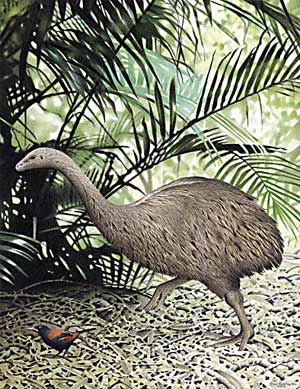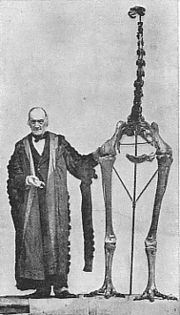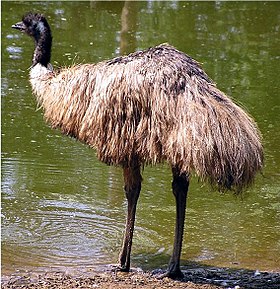
January 6, 2008

The little blue moa.
The Thylacine of the Avian world is in the news again.
Australian cryptozoologist Rex Gilroy recently discussed the latest new findings for Moas with the Hawke’s Bay Today. One of the good points about Gilroy is that he does serve as a lightning rod for unusual animal accounts in the region sometimes, and likewise has the ear of the media. The press reports tend to lower the ridicule curtain and more reports and sightings, historical and recent ones, then come forth.
Most of the cryptozoological attention to the survival of the Moas has been directed to the reports, sightings, and photographs from New Zealand, as you can see here, here, and here.
Australia’s Gilroy will be journeying to New Zealand’s remote Urewera ranges – home of the Tuhoe, known as the “Children of the Mist” because of the area’s misty forests – to search for the cryptid Moa.
The discovery of the fossil Moa is perhaps well-known. William Colenso (1811–99) was the first to note them. During his first years (1834-1838) at the Bay of Islands, Colenso made several significant missionary journeys. In 1838, he accompanied the Rev. W. Williams on a visit to the Bay of Plenty and East Coast districts. During this journey he first heard from the Maoris of the moa, bones of which he was later able to examine. He wrote an important paper, dated May 1, 1842, for the Tasmanian Journal of Natural Science, which was the first report of an observer on the spot pointing out the nature of the discovery.
A few years later Sir Richard Owen (below) would receive fossil specimens, ponder what they were for four years, and then describe zoologically the first moa.

Today, while reports of living Moas may be hard to believe, sightings of the smaller variety do occur, and Gilroy’s news is worthy of a good read. Caution, of course, must be stated, as escaped emus from Australia, loose in New Zealand, may be confusing the current picture of what cryptids are around and what escaped animals may be thereabouts.

The Australian emu (Dromaius novaehollandiae)
Nevertheless, Gilroy’s expedition in pursuit of this information will be intriguing to learn more about. Best of luck to these mates in Oz.
As many as a dozen moa could be fossicking in remote bush in northernmost Hawke’s Bay, according to Australian “hidden animal” hunters.
Next month they plan to resume the search – confident it’s only a matter of time before a colony is found.
The hopes are held by New South Wales cryptozoologist Rex Gilroy, who says hard-track evidence he and wife Heather found in the Urewera Ranges in November is a sign of the existence of the presumed-extinct Anomalopteryx didiformis, otherwise known as the little scrub moa.
The evidence of a track comes six years after the couple found about 35 ground prints they believe to have come from a colony of up to 12 of the moa.
Speaking from the couple’s Australasian Cryptozoological Research Centre in Katoomba, Mr Gilroy told Hawke’s Bay Today the evidence is enough to make them return at the end of February to search for the one piece of evidence he’s wanted for as much as 50 years to prove moa are still alive.
The latest find includes a track and what appeared to have been a recently-used nest in big, dead kauri. Moa had possibly nested there, and moa may have come out at night to move across a small isolated gully and onto a ridge in the area. Mr Gilroy has plaster casts of the tracks.
“The location is in pretty remote country, we need to have more time to investigate, and if I can get something on film, that would be tremendous.”
He’s not yet identifying the site, and, conceding only that the couple have entered the Ureweras from the Hawke’s Bay side, says he doesn’t want a lot of noise in the hunt for the species, which stood up to 1.3 m.
Previous revelations of hidden-animal kind had sparked invasions of media with cameras, bright lights and helicopters, and gleeful claims that it was all for nothing after a month of racket, which was hardly likely to encourage the big birds to make their long-awaited debut in public.
“I’ve devoted my whole life to the research of these creatures,” said 64-year-old Mr Gilroy.
“And the only way to find them is to go into the environment, just one, two or three people, and wait quietly.”
“You’ve got to be silent in the bush if you’re going to see anything,” he said.
“New Zealand is my favourite place, there is some pretty inaccessible terrain.”
He said it was possible that animal life could survive in such circumstances for “hundreds of years” without being seen by human beings.
Wairoa Land Search and Rescue and Urewera veteran Dave Withers says, however, that with large teams of volunteers covering huge areas of the forest park in searches and training each year he would have heard if some sign of the assumed-extinct birds had been found.
“I’ve never heard of them,” he said.
“With the amount of ground our guys cover, 40 to 60 people, they spread out and cover the ground – surely if they were about in this area I would have heard.”
He said there was “the odd wallaby” in the park, and larger-than-average feral cats, but he was not aware of reports of mystery tracks.
Anomalopteryx didiformis was a flightless bird species known colloquially as the Lesser or Bush Moa. It weighed 30kg and inhabited much of the North Island and small sections of the South Island.
The most complete remains, a partially articulated skeleton with substantial mummified tissue discovered in the South Island in 1980, are now in the Southland Museum.
Cryptozoology is the study of or search for animals which fall outside of contemporary zoological catalogues.
The focus is on finding living examples of animals taxonomically identified through fossil records, but which are believed to be extinct, and animals that fall outside of taxonomic records due to a lack of evidence, apart from myths, legends, or unconfirmed sightings. ~ by Doug Laing, “Birdman says moa surviving in the Bay,”
Hawke’s Bay Today, January 5, 2008.

(Thanks to Craig Woolheater for passing this along to me for my comments while I was in New York City, in my own search for more on the Abominable Snowmen.)
About Loren Coleman
Loren Coleman is one of the world’s leading cryptozoologists, some say “the” leading living cryptozoologist. Certainly, he is acknowledged as the current living American researcher and writer who has most popularized cryptozoology in the late 20th and early 21st centuries.
Starting his fieldwork and investigations in 1960, after traveling and trekking extensively in pursuit of cryptozoological mysteries, Coleman began writing to share his experiences in 1969. An honorary member of Ivan T. Sanderson’s Society for the Investigation of the Unexplained in the 1970s, Coleman has been bestowed with similar honorary memberships of the North Idaho College Cryptozoology Club in 1983, and in subsequent years, that of the British Columbia Scientific Cryptozoology Club, CryptoSafari International, and other international organizations. He was also a Life Member and Benefactor of the International Society of Cryptozoology (now-defunct).
Loren Coleman’s daily blog, as a member of the Cryptomundo Team, served as an ongoing avenue of communication for the ever-growing body of cryptozoo news from 2005 through 2013. He returned as an infrequent contributor beginning Halloween week of 2015.
Coleman is the founder in 2003, and current director of the International Cryptozoology Museum in Portland, Maine.
Filed under Breaking News, Cryptotourism, CryptoZoo News, Cryptozoologists, Cryptozoology, Expedition Reports, Extinct, Living Fossils, Media Appearances, Men in Cryptozoology, Thylacine